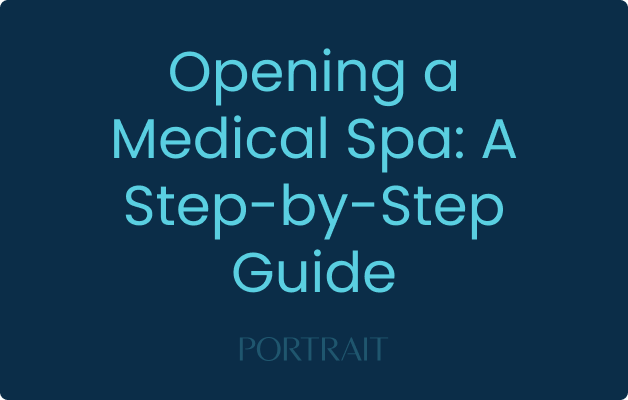Opening a Medical Spa: A Definitive Step-by-Step Guide for Success

Empowering Professionals at Every Stage
Portrait offers strategic expertise to help you make informed decisions and achieve long-term success.
Book Intro CallOpening a medical spa, often referred to as a "med spa," is a significant entrepreneurial undertaking with the potential for substantial rewards. Single-location medical spa businesses in the U.S. generate around $1.9 to $2 million in annual revenue, with industry profit margins typically ranging between 20% and 25%. However, the path may seem fraught with complex regulatory hurdles, operational demands, and intense market competition.
This guide will provide you with a definitive, step-by-step framework on how to navigate through all of this. All so you can establish a compliant, profitable, enduring, and successful medical spa as well as a roadmap for a loyal customer base.
Did you know, 83% of med spa clients consider themselves regulars, with monthly visits becoming the norm, underscoring the loyalty and repeat nature of the customer base? Let’s get to business.
Before You Begin: Introduction to the Medical Spa Industry
Before committing resources, you should have a clear, comprehensive understanding of the environment in which your med spa will operate. This doesn’t mean that med spa business owners have to be medical professionals or aestheticians. However, this foundational knowledge will inform your business decisions.
What Exactly Is a Med Spa?
A medical spa is a hybrid establishment. It blends the relaxing ambiance of a traditional day spa with the advanced medical procedures typically found in a doctor's office. Unlike conventional spa services that focus on relaxation and superficial aesthetic treatments, med spas offer medical-grade aesthetic procedures performed under the supervision of a licensed physician.
These procedures include, but are not limited to, Botox and dermal filler injections, laser hair removal, chemical peels, microdermabrasion, body contouring, and advanced skin rejuvenation therapies. The critical distinction lies in the medical oversight and the invasive nature of many of the treatments offered. You are not merely opening a beauty salon; you are establishing a medical facility with a spa aesthetic. Combined? It's a medical aesthetic.
Why Own a Med Spa?
The medical spa industry is experiencing robust growth. Mostly driven by increasing consumer demand for minimally invasive cosmetic procedures and a greater acceptance of aesthetic enhancements across demographic groups in its target market.
Technological advancements continually introduce new, effective treatments, expanding the service offerings and potential revenue streams. Furthermore, demographic shifts, particularly an aging population seeking to maintain a youthful appearance, and younger generations embracing preventative aesthetic treatments, contribute to a widening client base.
This is an opportunity for med spa owners prepared to meet the increasing demands of the industry.
Regulatory Complexities of Owning a Med Spa
The most significant challenge in opening a med spa is navigating the complex and often ambiguous regulatory landscape. Unlike traditional spas, med spas are subject to medical practice laws, which vary significantly by state. These laws dictate who can own a med spa, who can perform specific procedures, the level of physician supervision required, and the protocols for patient consent and medical record-keeping.
Ignoring these regulations is an invitation for severe legal penalties, including fines, license revocation, and even criminal charges. You must proactively identify and comply with all federal, state, and local statutes pertaining to medical practice, corporate practice of medicine, scope of practice for various professionals (e.g., registered nurses, physician assistants, estheticians), and health and safety standards. This is not an area for guesswork. You must meet compliance and legal requirements.
Opening a Medical Spa Checklist
From conceptualizing your unique value proposition and services, to securing required licenses, funding, and the perfect location, every step must be carefully planned and executed. The comprehensive checklist that follows is designed to guide aspiring med spa owners through each crucial phase—ensuring compliance, mitigating risk, and establishing a strong foundation for day-to-day operations and sustainable growth in this rapidly evolving industry.
Use this checklist to transform your vision into a thriving, client-focused, and profitable business.
Step 1: Develop a Comprehensive Business Plan
Your business plan is the blueprint for your med spa. It is a dynamic document that articulates your vision, strategy, and operational details. Without a robust plan, you lack direction and clarity, making it impossible to secure financing or manage your venture effectively. This plan must include:
- Executive Summary: A concise overview of your entire plan.
- Company Description: Your mission, vision, legal structure, and unique selling proposition. What makes your med spa different?
- Market Analysis: Thorough research into your target demographic, market size, growth trends, and competitive landscape. Who are your clients, and who are your rivals?
- Service Offerings: A detailed list of all procedures you will provide, including pricing strategies.
- Sales and Marketing Strategy: How you will attract and retain clients.
- Management Team: An overview of your leadership, physician oversight, and key personnel.
- Operational Plan: Day-to-day procedures, scheduling, client flow, and facility requirements.
- Financial Projections: Detailed startup costs, projected revenue, profit and loss statements, cash flow analysis, and break-even analysis for at least three to five years. This must be realistic and thoroughly researched.
- Funding Request: If seeking external financing, specify the amount needed and how it will be utilized.
Step 2: Establish Your Legal Structure
Selecting the appropriate legal structure is a foundational decision with significant implications for liability, taxation, and administrative burden. Common structures include Sole Proprietorship, Partnership, Limited Liability Company (LLC), or Corporation (S-Corp or C-Corp).
For a med spa, due to the medical nature of services and inherent liability, an LLC or Corporation is almost always recommended to shield personal assets from business debts and lawsuits. Furthermore, some states have "corporate practice of medicine" doctrines that prohibit non-physicians from owning medical entities.
In such cases, you may need to establish a Physician-owned Professional Corporation (PC) or a management services organization (MSO) model, where a physician owns the medical side and a separate entity (e.g., your LLC) manages the non-medical operations. Consult with an attorney specializing in healthcare business law to determine the optimal, compliant structure for your specific state. This decision impacts your personal liability and the future scalability of your business.
Step 3: Navigate Licensure and Regulatory Compliance
This step is non-negotiable and requires meticulous attention. Secure all necessary federal, state, and local licenses and permits before opening your doors. This includes:
- Business Licenses: General operating licenses from your city and county.
- Medical Director: You must secure a licensed physician as your medical director. This physician is legally responsible for the medical protocols, supervision of staff, and patient safety within your med spa. Their involvement is paramount and often legally mandated.
- Facility Licensure: Depending on your state, your facility may require specific health department permits or even medical facility licensure.
- Professional Licenses: Ensure all practitioners (nurses, estheticians, PAs, NPs) hold current, valid licenses in your state and operate strictly within their scope of practice.
- HIPAA Compliance: Implement robust policies and procedures to protect patient health information (PHI) as mandated by the Health Insurance Portability and Accountability Act. This includes secure record-keeping, staff training, and privacy protocols.
- OSHA Compliance: Adhere to Occupational Safety and Health Administration standards for workplace safety, including proper handling of hazardous materials, bloodborne pathogen protocols, and emergency preparedness.
- Insurance: Obtain comprehensive liability insurance, including medical malpractice insurance for all practitioners, general liability insurance, and property insurance.
Failure to comply with any of these regulatory requirements can lead to severe penalties, including immediate closure of your business. Seek expert legal counsel to navigate these complexities.
Step 4: Secure Financing for Your Venture
Opening a med spa requires substantial capital investment. You must secure adequate funding to cover startup costs, operational expenses for the initial months, and a contingency fund. Common financing avenues include:
- Self-Funding/Personal Savings: Utilizing your own capital.
- Bank Loans: Traditional small business loans (e.g., SBA loans). Prepare a compelling business plan and robust financial projections.
- Investor Funding: Seeking capital from private investors or venture capitalists. This often requires giving up a stake in your company.
- Lines of Credit: For short-term capital needs or unexpected expenses.
- Equipment Leasing: Leasing expensive medical equipment can reduce upfront capital expenditure.
Clearly define your funding needs, create detailed financial projections, and be prepared to articulate your business vision and path to profitability to potential lenders or investors. Underestimating startup costs is a common, detrimental error.
Once the foundational planning is complete, focus shifts to the physical manifestation of your med spa.
Step 5: Select the Optimal Location
Location is paramount for a client-facing business. Your chosen site must be accessible, visible, and align with your target demographic. Consider:
- Visibility and Accessibility: Easy access from major roads, ample parking, and clear signage.
- Demographics: Is the area populated by your ideal client base (e.g., affluent, health-conscious individuals)?
- Proximity to Complementary Businesses: Located near gyms, upscale boutiques, or other health and wellness centers can create synergistic opportunities.
- Foot Traffic vs. Destination Business: While some med spas thrive as destination businesses, good visibility can still drive incidental inquiries.
- Lease Terms and Costs: Evaluate rent, utilities, and potential for tenant improvements.
- Zoning Regulations: Ensure the property is zoned for commercial use and medical practices.
- Competition Analysis: Avoid oversaturated areas unless you have a strong differentiator.
A well-chosen location contributes significantly to client acquisition and convenience.
Step 6: Design Your Med Spa for Functionality and Aesthetics
Your med spa's design must strike a delicate balance between a soothing, luxurious aesthetic and clinical functionality. It must convey professionalism, cleanliness, and comfort.
- Client Flow: Design the space to ensure a smooth, private, and efficient client journey from reception to treatment rooms and back.
- Reception Area: Create an inviting, comfortable, and professional first impression.
- Treatment Rooms: Ensure they are adequately sized, private, well-lit, easily sanitized, and equipped with necessary power outlets and plumbing for medical equipment.
- Consultation Rooms: Provide private spaces for sensitive client discussions.
- Recovery Areas: If offering more invasive procedures, a discreet and comfortable recovery space is essential.
- Sterilization and Storage: Dedicated, compliant areas for instrument sterilization and secure storage of medical supplies.
- Restrooms: Clean, well-maintained, and accessible.
- Interior Design: Utilize a calming color palette, appropriate lighting, comfortable furnishings, and subtle branding elements. The environment should feel luxurious but also inspire confidence in the medical expertise provided.
- Compliance with ADA: Ensure your facility is compliant with the Americans with Disabilities Act.
A thoughtful design enhances the client experience and supports efficient operations.
Step 7: Procure Essential Equipment and Technology
The quality and efficacy of your equipment directly impact the results you can deliver and your reputation. Invest in reliable, industry-leading technology.
- Medical-Grade Equipment: Lasers (for hair removal, skin rejuvenation, tattoo removal), intense pulsed light (IPL) devices, radiofrequency devices, ultrasound devices, microdermabrasion machines, and other aesthetic treatment technologies. Research manufacturers thoroughly for efficacy, safety, and after-sales support.
- Examination and Treatment Tables: Comfortable, adjustable, and easy to clean.
- Sterilization Equipment: Autoclaves and proper instrument processing tools.
- Client Management Software (CRM): Essential for scheduling appointments, managing client records, tracking treatment history, sending reminders, and processing payments. This integrates medical record-keeping with business operations.
- Electronic Health Records (EHR) System: A secure, HIPAA-compliant system for detailed medical charting. This may be integrated with your CRM or a separate system.
- Medical Spa Software: For billing, inventory, and overall operational oversight.
- Basic Office Equipment: Computers, printers, phones, and a robust internet connection.
- Safety Equipment: Emergency kits, AEDs, and fire safety equipment.
Prioritize equipment that offers proven results, is backed by scientific research, and complies with all safety standards. Lease options for high-cost items can alleviate initial financial strain.
With your physical space taking shape, focus shifts to the human element and operational infrastructure.
Step 8: Assemble Your Expert Team
Your team is the face of your med spa and the cornerstone of its success. Hiring competent, licensed, and compassionate professionals is non-negotiable.
- Medical Director: A licensed physician (MD or DO) who provides medical oversight, develops protocols, delegates medical tasks, and is legally responsible for medical treatments. Their active involvement is crucial.
- Registered Nurses (RNs) / Nurse Practitioners (NPs) / Physician Assistants (PAs): Qualified to perform injections (Botox, fillers), laser treatments, and other advanced procedures under physician supervision, as dictated by state scope of practice laws.
- Licensed Estheticians: Perform less invasive treatments such as facials, chemical peels, and microdermabrasion. Their scope of practice is strictly defined by state regulations.
- Front Desk/Client Care Specialists: Provide exceptional customer service, manage scheduling, handle inquiries, and process payments. They are the first and last point of contact for clients.
- Marketing/Social Media Specialist (optional initially): To manage your online presence and promotional efforts.
Conduct thorough background checks, verify all licenses, and invest in ongoing training to ensure your team remains proficient in the latest techniques and safety protocols. A well-trained, cohesive team delivers superior client experiences and results.
Step 9: Define Your Signature Services
While offering a range of popular treatments is important, establishing signature services differentiates your med spa and attracts a specific clientele.
- Core Offerings: Identify the fundamental services you will provide based on your market research and medical director's expertise (e.g., neurotoxins, fillers, laser hair removal, medical-grade facials).
- Specialized Treatments: Consider niche services that address specific client needs or align with your unique brand (e.g., advanced body contouring, specialized IV therapy, hormone replacement therapy, regenerative aesthetics).
- Package Deals: Create attractive packages that combine multiple treatments for enhanced results and perceived value.
- Product Sales: Incorporate a curated selection of medical-grade skincare products that complement your services and provide an additional revenue stream.
- Pricing Strategy: Develop a competitive yet profitable pricing structure. Consider package pricing, membership options, and loyalty programs.
Regularly evaluate market trends and client feedback to refine and expand your service menu, ensuring it remains relevant and desirable.
Step 10: Implement Robust Operational Systems
Efficient operational systems are the backbone of a smooth, compliant, and profitable med spa. Without them, chaos ensues, leading to client dissatisfaction and regulatory issues.
- Client Management System (CMS) / EHR: As mentioned, this is central for appointments, client records, billing, and communication.
- Standard Operating Procedures (SOPs): Develop detailed SOPs for every aspect of your operations, including:
- Client intake and consultation.
- Treatment protocols for each service (including pre- and post-care instructions).
- Sterilization and infection control.
- Emergency protocols (anaphylaxis, adverse reactions).
- Client privacy (HIPAA compliance).
- Inventory management.
- Financial transactions and reporting.
- Staff training and performance reviews.
- Inventory Management System: Track products, supplies, and injectables to minimize waste and ensure you never run out of essential items.
- Financial Accounting System: Implement robust accounting software and processes for accurate bookkeeping, payroll, and financial reporting.
- Quality Control and Assurance: Establish mechanisms to monitor treatment efficacy, client satisfaction, and safety standards.
- Risk Management: Proactively identify and mitigate potential risks, including patient safety, legal compliance, and financial stability.
Well-documented and consistently followed SOPs ensure consistency, enhance safety, and streamline operations, reducing errors and improving efficiency.
Once your med spa is physically ready and operationally sound, the focus shifts to attracting clients and establishing your brand.
Step 11: Develop a Strategic Marketing and Branding Plan
A compelling brand and targeted marketing are essential to attract your desired clientele. This is how you communicate your value proposition.
- Brand Identity: Define your med spa's unique personality, values, and visual elements (logo, colors, typography). What message do you want to convey?
- Website Development: Create a professional, mobile-responsive website that clearly showcases your services, team bios, location, and contact information. Integrate online booking.
- Search Engine Optimization (SEO): Optimize your website content to rank higher in local search results for relevant keywords.
- Social Media Marketing: Establish a strong presence on platforms where your target audience is active (e.g., Instagram, Facebook, TikTok). Showcase before-and-after photos (with client consent), share educational content, and engage with your followers.
- Content Marketing: Create valuable blog posts, videos, or guides related to aesthetic treatments to establish your expertise.
- Email Marketing: Build an email list and send newsletters, promotions, and treatment updates.
- Local Advertising: Consider local print ads, partnerships with complementary local businesses, or community sponsorships.
- Online Reviews Management: Actively encourage satisfied clients to leave positive reviews on platforms like Google, Yelp, and specialized directories. Respond professionally to all reviews, positive or negative.
- Promotions and coupons: Offer coupons on platforms like Groupon to pull in your first customers!
Your marketing efforts must be consistent, professional, and compliant with all advertising regulations, especially for medical services.
Step 12: Execute a Grand Opening Strategy
A well-executed grand opening creates initial buzz and attracts your first wave of clients. This is your formal introduction to the market.
- Pre-Launch Buzz: Announce your upcoming opening through social media, local press releases, and targeted email campaigns.
- Grand Opening Event: Host an open house or a special event. Offer tours of the facility, free mini-consultations, product demonstrations, and exclusive opening day discounts.
- Partnerships: Collaborate with local influencers, beauty bloggers, or complementary businesses for cross-promotion.
- Introductory Offers: Provide special discounts or package deals for new clients during the initial launch period.
- Media Outreach: Invite local media representatives to your grand opening to generate press coverage.
The goal is to generate excitement, showcase your facility, and convert initial interest into booked appointments.
Step 13: Prioritize Client Retention and Feedback
Acquiring new clients is expensive; retaining existing ones is far more cost-effective and essential for long-term profitability.
- Exceptional Client Experience: Consistently deliver outstanding service, from the moment a client books an appointment to their post-treatment follow-up. Personalization and attentive care are key.
- Loyalty Programs: Implement reward programs or membership tiers to incentivize repeat business.
- Follow-Up Communication: Send personalized thank-you notes, post-treatment care instructions, and reminders for future appointments.
- Solicit Feedback: Actively request client feedback through surveys, direct conversations, and online reviews. Use this input to identify areas for improvement and demonstrate that you value their opinion.
- Address Concerns Promptly: Respond to any client concerns or complaints quickly, empathetically, and effectively. Turning a negative experience into a positive one can build lasting loyalty.
A strong focus on client retention builds a stable client base, fosters positive word-of-mouth referrals, and enhances your brand reputation.
Sustaining Your Med Spa's Success
Opening your med spa is just the beginning. Long-term success requires continuous effort, adaptation, and strategic management.
Continuous Education and Adaptation
The aesthetic medicine industry is dynamic, with constant advancements in technology, techniques, and scientific understanding. To remain competitive and relevant, you must embrace continuous learning. Invest in ongoing training for yourself and your entire team.
Attend industry conferences, workshops, and specialized courses to stay abreast of the latest trends, regulatory changes, and breakthrough treatments. Regularly evaluate new equipment and service offerings. Adapting to evolving client demands and technological innovations is not optional.
Financial Management and Profitability
Diligent financial management is paramount for the health and longevity of your med spa. Beyond initial funding, you must meticulously track revenue, expenses, and profitability. Regularly review your financial statements—profit and loss statements, balance sheets, and cash flow reports—to identify trends, manage costs, and make informed business decisions.
Monitor key performance indicators (KPIs) such as average client spend, client acquisition cost, client retention rates, and profit margins for each service. Optimize pricing strategies, control inventory, and manage staffing levels effectively to maximize profitability. Reinvest a portion of your profits into business improvements, staff training, and equipment upgrades. Without robust financial oversight, even a busy med spa can falter.
Scaling and Expansion Opportunities
Once your initial med spa is established and consistently profitable, consider opportunities for scaling and expansion. This could involve:
- Expanding Service Offerings: Introducing new, in-demand treatments or product lines.
- Opening Additional Locations: Replicating your successful model in new geographic areas. This requires a proven, standardized operational system.
- Franchising: Developing a franchise model to allow others to open med spas under your brand. This is a complex undertaking requiring significant legal and operational infrastructure.
- Strategic Partnerships: Collaborating with complementary businesses (e.g., plastic surgeons, dermatologists, wellness centers) to expand your reach and referral network.
Any expansion must be meticulously planned, financially viable, and maintain the high standards of quality and compliance you established with your initial venture. Growth without control can lead to dilution of quality and financial instability.
Open a Medical Spa with Portrait Care
Opening a medical spa is a challenging but potentially highly rewarding endeavor. By following these steps, adhering to all regulatory requirements, and committing to continuous improvement, you can build a reputable, profitable, and enduring business that serves the growing demand for aesthetic medical care
Portrait Care can help. We make the entire process of opening a medical spa easier with our free EHR and services and supplier savings of up to 60%. That’s why more than 1,000 clinics nationwide trust us as their operating system for growth.
One Platform.
Everything You Need.
Everything You Need.
Portrait combines the technology, support, and savings to run and scale your modern medical wellness business.
Book Intro Call
Stay Connected with Portrait Care
Subscribe to our email list and receive the latest insights, updates, and exclusive content delivered straight to your inbox.



.png)
.png)
.png)